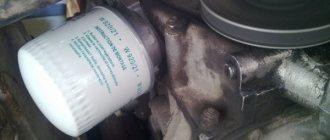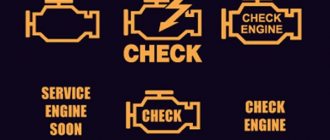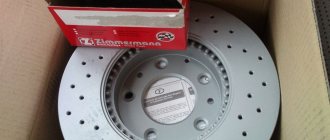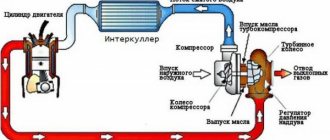Motorists encounter the consequences of underfilling engine oil more often than with its excess. However, one should not expect a positive outcome from excess volume. In the article we will explain what will happen if you pour oil into the engine, and how to return the normal level of this fluid.
Excessive volume affects engine performance, disabling some systems, misaligning sensors and increasing oil consumption. Especially if there is a significant excess of the norm.
How to check engine oil level
Checking the oil level is carried out using a special dipstick. It is fixed to a sealed plug that is permanently inserted into the hole in the cylinder block. For an accurate check, you need to start the car and warm it up at idle for about 10 minutes to obtain the desired fluid viscosity.
Measuring the oil level in the engine
After this, you need to turn off the engine and wait a few minutes for the bulk of the oil to drain into the oil pan. We take out the dipstick and wipe its lower part with o and “max” dry, without leaving any oil or rag residue on the dipstick. Next, return the meter to the hole, inserting it all the way, and carefully remove it again.
If this metal rod is smeared with engine oil above the minimum and below the maximum level, then the level of this fluid in the system is normal. If the rod is smeared significantly higher than o, then this indicates that there is an overflow in the engine.
Why have engine oil change intervals increased?
Before, friends, we tell you about all the technical details, we would like to note that long oil change intervals are a very well-thought-out marketing ploy of any automaker. After all, the consumer understands that the less frequently the oil in a car is changed, the less costs it will cost him to maintain the car during its operation.
When it comes to changing the oil in an internal combustion engine, all drivers without exception (even blondes) understand that this is necessary to lubricate the internal parts of the power unit.
There are three main engine components that require lubrication.
-Firstly, oil is necessary for the operation of the crankshaft, connecting rods and main bearings.
-Secondly, this lubricant is also necessary for cylinders, gears and camshafts, as well as other elements and the timing mechanism.
Modern engines with valve timing systems have become more demanding on the quality of engine oil. For example, the configuration of modern camshafts has become more innovative and radical, i.e., the valve lift and opening interval have become much larger. As a result, it turns out that more force was required to open the valves, and the mechanical load on the camshafts themselves increased.
This is one of the reasons why modern power units require the use of high-quality motor oils with various chemical additives.
But despite the fact that this design of modern engines has changed significantly over the past 20 years, the cylinder wall lubrication system itself has remained the same. And this despite the fact that the new engines have become more revving and the configuration of their pistons has changed significantly.
Additives and auto chemicals: Which products don’t help?
There is a common misconception, namely, the higher the engine can gain speed, the more demanding it is on the quality of the oil. But in reality, everything is completely different; in such engines, the same principle of lubrication of all components of the power unit is used, which was used 20 - 30 years ago.
Consequences of overflow
Liquids expand as temperature increases. Due to this process, the pressure on seals, oil seals, gaskets increases, even to the point of deformation of the sealing elements. After this, they cannot do their job and leaks begin, while the pressure in the system decreases and oil consumption increases.
The butter is whipped into foam
During a critical increase in pressure, pulsed emissions occur. It is also possible that the spark plugs will flood and there will be problems with ignition, loss of power, and increased fuel consumption. The same symptoms occur during pulse emissions when the mass fuel flow sensor is flooded. It begins to give incorrect readings, which leads to additional overspending.
If there is a significant excess of lubricating fluid in the system, the crankshaft remains in this volume almost all the time. With its counterweights, it whips everything into foam while working. Air bubbles form, reducing uniformity. Such consequences of oil overflow into the engine lead to airing of the hydraulic compensators and their incorrect operation. Shock loads occur on other components of the gas distribution system, leading to rapid wear out of parts.
Also, if the design of the aired unit is non-separable, then it will have to be replaced . However, the cost of this element is quite high.
Increasing pressure in the lubrication system puts a significant load on the oil pump. Its gears are subject to unreasonably high wear. In addition, air bubbles can carry dirt particles from the oil pan further through the system. This process clogs the oil filter faster.
You need to know that the consequences of overfilling manifest themselves to a greater extent on cars with a significantly exhausted resource.
Motors with high output almost immediately react to overflow in the form of a few millimeters of excess on the dipstick with leaks from under the seals. The strategy of waiting for the excess oil to burn off on its own is ineffective. During this period, other, sometimes more serious, damage may occur.
Removing the filter
For new cars, a small overflow does not have such dire consequences as for older cars. But if the problem is not solved for a long time, then troubles may arise. Therefore, it is worth quickly getting rid of significant excess oil.
Signs of oil starvation
To accurately determine whether the engine is starving, it is necessary to at least remove the valve covers, inspect the camshaft and rockers (aka valve rockers). It is these units that operate under conditions of constant friction and load; with the slightest lack of lubrication, they will begin to wear out.
Without removing the valve covers, it is much more difficult to make a diagnosis. Indirect signs may be a general deterioration in strength, extraneous noises and knocking, but they can also be signs of other malfunctions.
Article on the topic: How to remove the alternator belt tensioner and replace it
The reasons why oil starvation may occur can be divided into objective and subjective. Let's look at the reasons and actions that determine them.
Ways to remove excess motor oil
To drain a small amount of excess lubricating fluid, you can briefly unscrew the oil filter. Place a container under the hole. After waiting a little until a sufficient amount has drained, you need to screw the filter back in. If the level is significantly exceeded, then the excess will have to be removed through the drain plug, unscrewing it for a short period, or through the hole in the dipstick to check the level.
Traditionally, a medical syringe for several cubes and a flexible tube from a dropper are used. Having firmly connected one end of the hoses to the syringe, lower the second into the hole. After pumping out some of the oil, you can check and repeat the operation if necessary. This procedure must be carried out when the engine has cooled down.
Removing excess oil from the system
If a larger volume of oil has been removed than expected, it can always be added back into the system to the required level.
Is it possible to change engine oil rarely?
For a long time, many auto experts, in order to answer this question, conducted various studies with one goal, to find out the level of engine oil degradation (aging) with normal interval runs that the automakers themselves recommend.
This was necessary to understand how the properties of the oil change during the operation of the machine, immediately after changing the engine fluid and before the next scheduled replacement.
Moreover, many experiments were close to real conditions of car ownership. So, for example, during the research, experts repeated the frequent habits of drivers, i.e., their car was often stuck in traffic jams or was often driven in sports mode, etc. and so on.
Then, after a certain mileage, the oil was drained from the engine and checked with a special tester that measures the dielectric constant of the oil. This oil property is closely related to the degradation (loss of properties) of the engine oil.
Dielectric constant, in principle, has nothing to do with the quality of the oil itself, but it is this very indicator that indicates the exhaustion of motor oil in the engine. The point is this: the more various impurities, particles or other contaminants in the used oil, the lower its dielectric constant.
As a result of numerous studies, it turned out that during the operation of any car with an internal combustion engine, the oil in the power unit loses its properties in different ways. Everything specifically depends on the operating conditions of the machine.
So remember, friends, if you often drive your car long distances on the highway and rarely start it, then the oil retains 40% of its properties after a mileage of 10,000 thousand km. If you use the car more often for short distances with a large number of cold starts, then by the mileage of 10,000 thousand km the oil will retain its original properties by only 5%.
See also: How to check the oil in the gearbox?
Also further, as a result of these studies, experts realized that the degradation of motor oil (deterioration of the lubricating and protective properties of the oil) is mainly associated with the chemical processes that occur in the liquid during engine operation. So, dear friends, the opinion that oil loses its properties only due to physical wear of engine parts (which supposedly clog the oil) during their friction is wrong.
Of course, we all know that over time, any motor oil in the engine begins to darken, but this is not a sign of loss of oil properties. Yes, the oil has darkened due to the accumulation of some contaminants in it. But most often, darkened oil does not become less viscous. And this is the main thing for any engine. That is, from here the conclusion is that if the oil has become more liquid, then it will no longer be able to provide the engine with proper protection and therefore must be replaced. So remember for the future that the dark color of the engine oil cannot indicate that it has lost its properties and perhaps this fluid in the engine is still quite normal.
Thus, we have understood that the main enemy of motor oil cannot be the following parameters: - not mechanical loads in the engine, not the shift phases of the gas distribution system, not pressure and not even high temperature. Most of these problems are related specifically to chemicals that form in motor oil, namely, the accumulation of sulfur and an increase in oil acidity.
All this causes chemical corrosion inside the engine crankcase and its bearings.
Plus, to all this we must add various modern chemical additives introduced into the fuel (which in Russia already leaves much to be desired), as well as various electronic fuel systems that regulate different fuel mixtures, which is why we get a more accelerated oxidation process motor oil.
Of course, oil manufacturers know about all this and, having balanced the above chemical properties, add special additives to modern oils, strictly dosing them depending on the brand and type of fluid for all modern power units.
Yes, some oil manufacturers still produce the same (many) motor oils with the same chemical formulas as they did 20 years ago. But in general and in particular, all modern lubricants are very different from those lubricants of yesteryear.
In addition, our auto industry is currently living in a synthetic era when motor oils have become entirely a product of the chemical industry. So, for example, if previously the basis of any oil was specifically oil and its refined product (mineral oils), today many synthetic lubricants are created and are created entirely from chemical elements.
It is worth noting that synthetic oils have a longer service life compared to mineral or semi-synthetic lubricating fluids. Thanks to this, today it has become possible to increase the maintenance interval of modern cars.
Among other things, we often see that oil manufacturers produce their own individual motor oil for each brand and even model of car, which was specially designed for a certain type (model) of car. Such oils, as a rule, use a special additive package that is ideal only for a certain modification of the engine or car model.
True, it won’t be some incredible and special oil. In principle, such oil, which was created specifically for a specific car model, is based on the same synthetic or mineral lubricant. The manufacturer simply added a set of special additives to regular oil and that’s it.
These additives are the determining factors for the quality of the oil. The more expensive the additives in the oil, the better the lubricating properties it contains, which means the slower the process of its oxidation inside the engine itself, which directly affects the aging of the engine oil (loss of viscosity and other important properties).
As a result, we find that the quality of the oil affects the frequency of scheduled engine oil changes.
Currently, there are only a few large manufacturers of chemical additives for motor oil in the world. Previously, this additive market looked different. For example, just 10 years ago, chemical additives to oils were produced by hundreds of small chemical plants located around the world.
But ultimately, this very market is currently divided between a few companies. This led to the fact that each manufacturer of chemical additives began, in principle, to produce chemical additives for oil of almost the same properties and quality.
Aging and degradation of lubricants ultimately depends on the additives that the manufacturer uses. That is why, when setting the vehicle service interval, car manufacturers indicate in the vehicle’s operating manual the type and brand of motor oils approved for use.
As a result, we get that if these intervals between oil changes are not observed, then this fluid will no longer be able to properly protect the internal components of the engine due to such harmful chemical processes.
However, it is worth noting that the condition of the oil is affected not only by its replacement interval and chemical additives in the liquid. For example, the aging of engine oil is also affected by the design of the power unit itself, as well as the oil temperature, filtration quality and the remaining oil in the engine after its scheduled replacement.
That is, if you do not completely drain the used oil, the new motor oil will lose its properties faster than specified by the manufacturer. As a result, the oil change interval in this case must be shortened.
In conclusion, dear friends, we would like to note the following that a long oil change interval in modern cars, by its very nature, does not lead to rapid wear of the power unit, but all this is true only if a number of conditions and rules are met.
The main rule here is the quality of the oil poured into the engine. Remember, friends, that we should only fill our car’s engine with oils that are recommended by the car manufacturer.
In addition, the vehicle must be operated in the normal manner as envisaged by the engineers during the development of the vehicle.
See also: Should you change your engine oil often?
For example, a regular passenger car should be used on normal roads and should not be used for sport driving. If you plan to use the car for sports, then the engine oil should be replaced with a brand that is created for sports use of the power unit. You also need to remember that in this case the oil change interval should be shortened.
If we fill the car with bad fuel, often use it for short distances and, moreover, constantly drive at high engine speeds and at the same time change the oil as recommended by the manufacturer, then the service life of the engine will unfortunately be significantly reduced, and this will happen very, very fast.
If we want to change the oil rarely, i.e. at long intervals, then we must follow the rules we have mentioned above.
Also, you need to pay attention to the fact that as the mileage of the car becomes more and more, the amount of these gases penetrating into the crankcase increases. This means that even with a short mileage of the car after changing the engine oil, there will be a large amount of carbon, dirt and other deposits present in the engine. Ultimately, the oil change interval must be shortened.
That is, the greater the mileage of the car, the faster the degradation (aging) of engine oil occurs. Remember friends, this is your enemy number 1. Therefore, after 50,000 thousand kilometers of a new car, the oil change interval should be reduced by approximately 10 - 20%.
See also: Five types of fluids that need to be checked in a car
Another noteworthy thing is that you will not find this very recommendation in any operating manual for any car. Remember, this is another marketing ploy by the automakers themselves. After all, they are not interested in you owning your car for a long time. They have a different task, namely, to ensure that you change your car to a new one as often as possible.
What negative consequences can occur if oils are combined incorrectly?
If there are differences in chemical formulas and different sets of additives, the products may conflict, which will certainly affect the work process. Try not to let your trunk run out of oil, so as not to get into a situation where you urgently need to add oil, but there is none. Manufacturers claim that using only one brand and brand of motor oil for your car can guarantee its long-term and trouble-free operation.
After unsuccessful experiments with the engine, slag and sediment accumulate in the engine, and this will certainly affect the engine parts and shorten its service life.
Do not take one oil in a part less than 15 percent, this poses a danger to the engine. This is exactly the amount that remains when changing the lubricant.
Engine oil starvation: consequences for the engine
Let's start with the fact that a slight drop in the engine oil level (for example, to the MIN mark on the dipstick) is usually not critical. In this case, it is necessary to add lubricant, taking into account the compatibility of the oils.
If the oil dipstick is completely dry, then you need to focus on the amount that was required for topping up. An indicator of about 0.5-0.7 liters (depending on the working volume of the internal combustion engine and the total amount of lubricant in the system) often does not lead to serious malfunctions.
We also recommend reading the article why there is no oil pressure in the engine. From this article you will learn about the main reasons for low oil pressure in the engine lubrication system.
The fact is that manufacturers calculate the oil volume and marks on the dipstick to control its level with a small margin. However, this does not mean that reducing the oil level is always without consequences for the engine. There are internal combustion engines for which a shortage of even 300-400 grams of oil may be critical.
The consequences of oil starvation include unstable engine operation and the unexpected appearance of bluish oil smoke. This indicates that the piston rings are stuck or that they are prematurely worn, and scuff marks may appear on the cylinder bore. Oiling of the spark plugs also occurs, as excess oil enters the combustion chamber.
A noticeable lack of oil often leads to problems with the timing belt. As a rule, the camshaft is the first to suffer. During rotation, strong heating occurs; without oil, the camshaft jams, and the camshaft bed in the cylinder head is damaged.
A critically low oil level in the crankcase often causes jamming of the crankshaft itself or the pistons in the internal combustion engine cylinders. As a result, extensive destruction of engine components occurs, and part of the cylinder block may be torn out. This situation usually leads to the need to completely replace the power unit without the possibility of restoring it.
The fact is that if the engine is running without oil and for this reason the crankshaft is jammed, then almost all components need to be changed: timing belt, crankshaft, cylinder-piston group, boring the cylinder block, etc. It turns out that it is more advisable to immediately purchase a working engine.
We also note that on turbo engines, for certain reasons, oil starvation of the turbine may occur. Given the high cost of this part, the quality and intensity of the supply of lubricant to the turbocharger should be regularly checked. Otherwise, even minor problems with lubrication can damage the element, since the turbine has a high rotation speed and the operating temperature of the turbocharger is very high.











